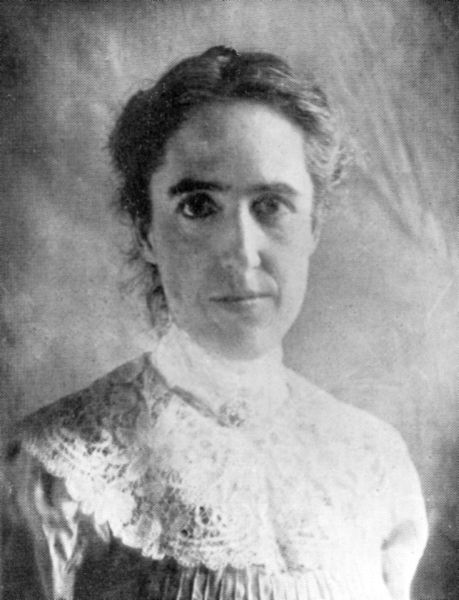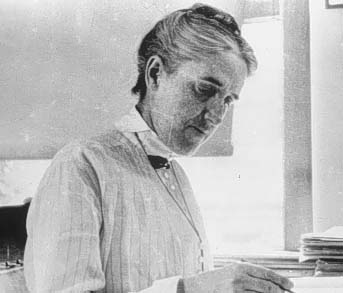<Back to Index>
- Astronomer Henrietta Swan Leavitt, 1868
- Writer Mao Dun (Shen Dehong), 1896
- Sultan of the Ottoman Empire Murad III, 1546
PAGE SPONSOR


Henrietta Swan Leavitt (July 4, 1868 – December 12, 1921) was an American astronomer. A graduate of Radcliffe College, Leavitt went to work in 1893 at the Harvard College Observatory in a menial capacity as a "computer", assigned to count images on photographic plates. Study of the plates led Leavitt to propound a groundbreaking theory, worked out while she labored as a $10.50 - a - week assistant, that was the basis for the pivotal work of astronomer Edwin Hubble. Leavitt's discovery of the period - luminosity relation of Cepheid variables radically changed the theory of modern astronomy, an accomplishment for which she received almost no recognition during her lifetime.
Henrietta Swan Leavitt, the daughter of Congregational church minister George Roswell Leavitt and his wife Henrietta Swan (Kendrick), was born in Lancaster, Massachusetts, a descendant of Deacon John Leavitt, an English Puritan tailor, who settled in the Massachusetts Bay Colony in the early seventeenth century. (The family name was spelled Levett in early Massachusetts records.) She attended Oberlin College, and graduated from Radcliffe College, then called the Society for the Collegiate Instruction for Women, with a bachelor's degree in 1892. It wasn't until her fourth year of college that Leavitt took a course in astronomy, in which she earned an A–.
Leavitt began work in 1893 at Harvard College Observatory as one of the women human ‘computers’ brought in by Edward Charles Pickering to measure and catalog the brightness of stars in the observatory's photographic plate collection. (In the early 1900s, women were not allowed to operate telescopes). She noted thousands of variable stars in images of the Magellanic Clouds. In 1908 she published her results in the Annals of the Astronomical Observatory of Harvard College, noting that a few of the variables showed a pattern: brighter ones appeared to have longer periods. After further study, she confirmed in 1912 that the variable stars of greater intrinsic luminosity – actually Cepheid variables – did indeed have longer periods, and the relationship was quite close and predictable.
Leavitt's discovery is known as the 'period - luminosity relationship' which is a curvilinear relationship that becomes a straight line relation between the luminosity and the log of the period. "A straight line can be readily drawn among each of the two series of points corresponding to maxima and minima," Leavitt wrote of her study of 1,777 variable stars recorded on Harvard's photographic plates, "thus showing that there is a simple relation between the brightness of the variable and their periods".
Leavitt used the simplifying assumption that all of the Cepheids in the respective Magellenic Clouds were approximately the same distances from the earth, so the relationship became key in determining Cepheid Scale Distance and absolute magnitudes beyond the realm of parallax measurement, once the absolute distance to one Cepheid could later be determined by astronomers. "Since the variables are probably at nearly the same distance from the Earth, their periods are apparently associated with their actual emission of light, as determined by their mass, density, and surface brightness." This relationship would provide an important yardstick for measuring distances in the Universe, if it could be calibrated. One year after Leavitt reported her results, Ejnar Hertzsprung determined the distance of several Cepheids in the Milky Way, and with this calibration the distance to any Cepheid could be determined.
At the time, it was not clear that there were millions of nebulae that were actually galaxies outside of our Milky Way galaxy.
Their distances were too extreme to be measured using parallax and the
Cepheid period - luminosity relationship provided the key to estimating
these distances. Cepheids were soon detected in other galaxies such as
the Andromeda Galaxy (notably
by Edwin Hubble in 1923 – 24). Cepheids were an important part of the
evidence that galaxies are far outside of the Milky Way and were key to settling the Great Debate as
to the nature of spiral nebulae and whether the Universe was larger
than the Milky Way. Our picture of the universe was changed forever,
largely because of Leavitt's discovery. The accomplishments of Edwin Hubble,
renowned American astronomer, were made possible by Leavitt's
groundbreaking research and Leavitt's Law. "If Henrietta Leavitt had
provided the key to determine the size of the cosmos,
then it was Edwin Powell Hubble who inserted it in the lock and
provided the observations that allowed it to be turned," wrote David H.
and Matthew D.H. Clark in their book Measuring the Cosmos. To his credit, Hubble himself often said that Leavitt deserved the Nobel for her work. Gösta Mittag - Leffler of
the Swedish Academy of Sciences had begun paperwork on her nomination
in 1924, only to learn that she had died of cancer three years earlier (the Nobel prize cannot be awarded posthumously). Leavitt
worked sporadically during her time at Harvard, often sidelined by
health problems and family obligations. An illness contracted after her
graduation from Radcliffe College rendered her increasingly deaf. By 1921, when Harlow Shapley took over as director of the observatory, Leavitt was made head of stellar photometry. By the end of that year she had succumbed to cancer, and was buried in the Leavitt family plot at Cambridge Cemetery in Cambridge, Massachusetts. "Sitting
at the top of a gentle hill," writes George Johnson in his biography of
Leavitt, "the spot is marked by a tall hexagonal monument, on top of
which (cradled on a draped marble pedestal) sits a globe. Her uncle Erasmus Darwin Leavitt and
his family are also buried there, along with other Leavitts. A plaque
memorializing Henrietta and her two siblings who died so young, Mira
and Roswell, is mounted directly below the continent of Australia. Off
to one side, and more often visited, are the graves of Henry and William James."
Leavitt was a member of
Phi Beta Kappa,
the American Association of University Women, the American Astronomical
and Astrophysical Society, the American Association for the Advancement
of Science, and an honorary member of the American Association of
Variable Star Observers. Her early passing was seen as a tragedy by her
colleagues for reasons that went beyond her scientific achievements. In an obituary her colleague, Solon I. Bailey,
noted, "She had the happy faculty of appreciating all that was worthy
and lovable in others, and was possessed of a nature so full of
sunshine that, to her, all of life became beautiful and full of
meaning."